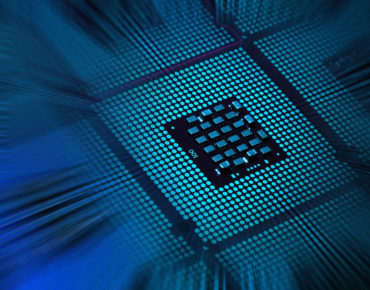U.S. Chip Initiative Aims For ‘Moore’s (Law) Inflection’

via Shutterstock
It is telling that the keynote speaker at a major U.S. computer engineering conference represents the Department of Defense, which is pouring billions of R&D dollars into new chip architectures, chip design tools, novel semiconductor materials and, most recently, optical interconnects for multichip modules.
All are expected to help advance high-performance computing and cloud infrastructure, along with parallel efforts aimed at pushing the frontiers of machine intelligence.
Among the goals is “creating inflections,” said William Chappell, who oversees the Defense Advanced Research Projects Agency’s (DARPA) Electronics Resurgence Initiative (ERI). The $1.5 billion chip initiative launched in June 2017 seeks to transform the Moore’s Law paradigm of the last half-century into “Moore’s Inflection,” Chappell told the IEEE Rebooting Computing conference on Wednesday (Nov. 7).
The DARPA effort also addresses the skyrocketing cost of chip development that can run to several billion dollars for a new GPU. Hence, chip design and manufacturing are the modern-day equivalent of building the pyramids, Chappell noted. “How do we take research and make large-scale change,” he added. “This is why we want to reboot computing.”
The agency has moved aggressively over the last year to address many of the barriers to achieving Moore’s Inflection, including long-standing agency themes related to the soaring cost and complexity of weapons development. Specifically, ERI confronts what Chappell called the “complexity bind” that starts with expensive chip design, fabrication and integration that further limits hardware innovation.
The agency also argues that the rise of software, and with it, abstraction, “is stifling potential gains in hardware,” Chappell said.
Then there are global and societal impacts that add to complexity, including foreign technology investments that are “distorting [technology] markets and driving a shift outside the U.S.,” added Chappell, who directs DARPA’s Microsystems Technology Office.
“We have a real [defense] industrial base crisis on our hands.” For example, the U.S. military’s only domestic source of advanced microelectronics is Globalfoundries.
As DARPA engages directly with chip makers and university researchers, it is attempting to transform the semiconductor industry largely guided by Moore’s Law scaling. For example, an intelligent electronic design effort launched last year looks to use chip design data as a differentiator to develop models that capture chip layout options and presents them as a new EDA tool.
The electronics initiative added a new theme earlier this month when DARPA announced a chip scaling effort called PIPES, for Photonics in the Package for Extreme Scalability. PIPES seeks to integrate high-capacity optical signaling technology into multichip modules, and do so at the chip level.
The photonics effort addresses the constraints imposed by data movement on current microelectronics, especially power and latency. Using optical rather than electrical components for data transfer is seen as a promising approach for reducing power consumption while increasing data capacity and reducing latency.
“Efficient photonic signaling offers a path to disruptive system scalability because it eliminates the need to keep data local, and it promises to impact data-intensive applications, including machine learning, large scale emulation and advanced sensors,” Gordon Keeler, a DARPA program manager, noted in announcing PIPES.
Meanwhile, Chappell said DARPA expects to announce another round of project funding for next-generation electronics research over the next several months.
Related
George Leopold has written about science and technology for more than 30 years, focusing on electronics and aerospace technology. He previously served as executive editor of Electronic Engineering Times. Leopold is the author of "Calculated Risk: The Supersonic Life and Times of Gus Grissom" (Purdue University Press, 2016).










